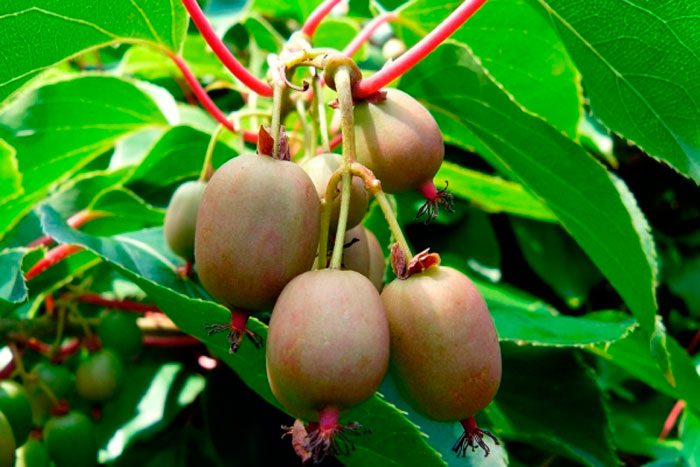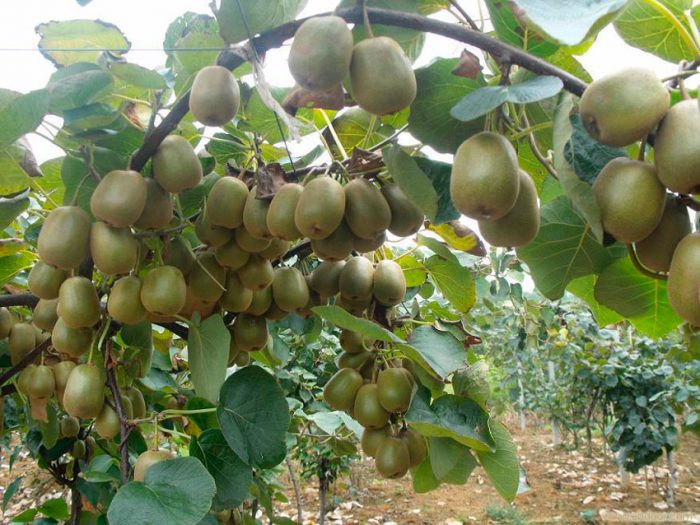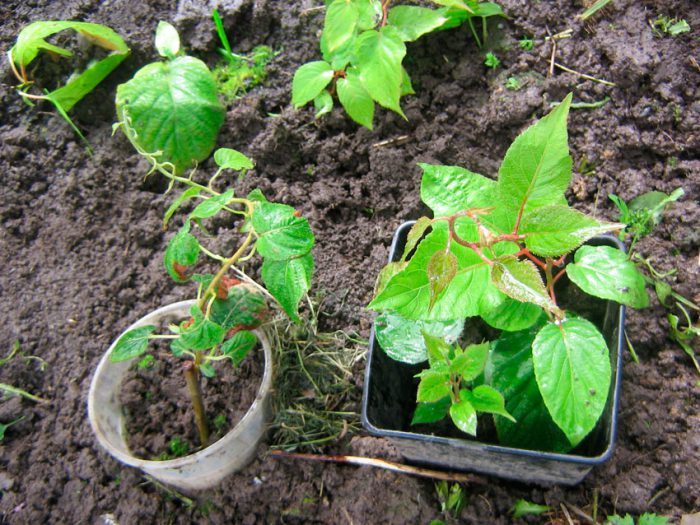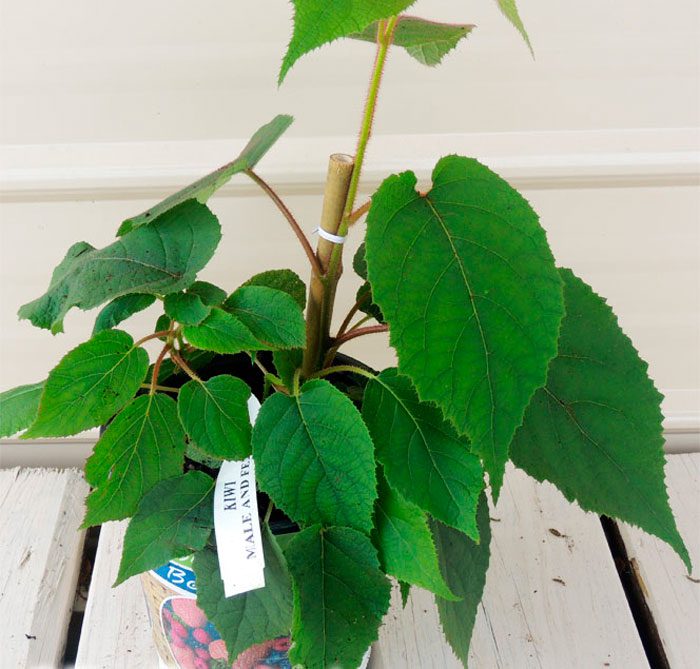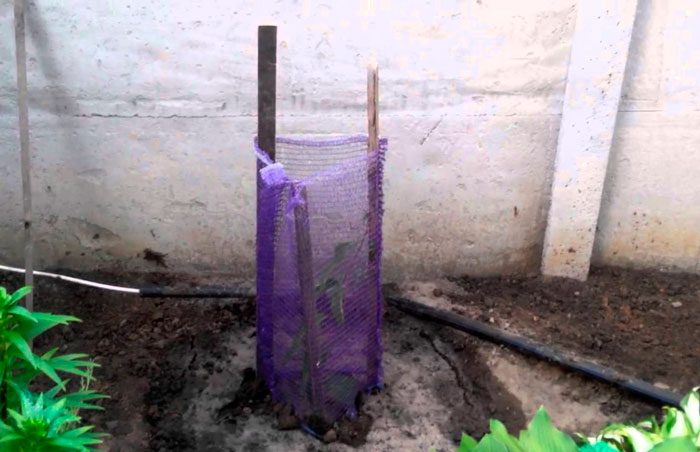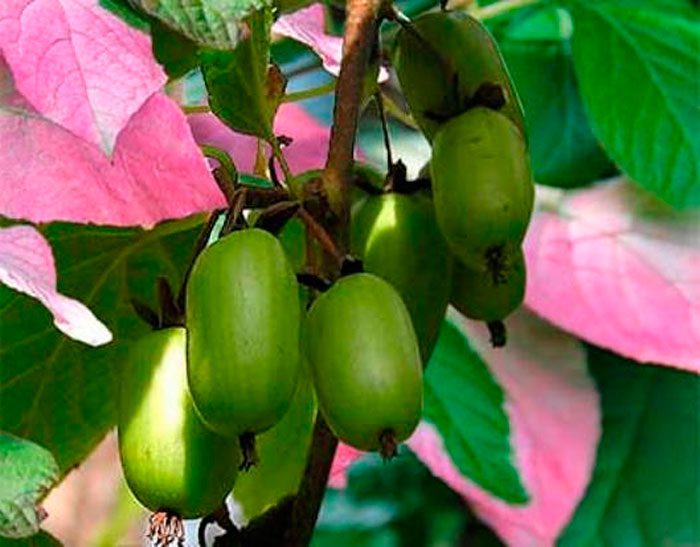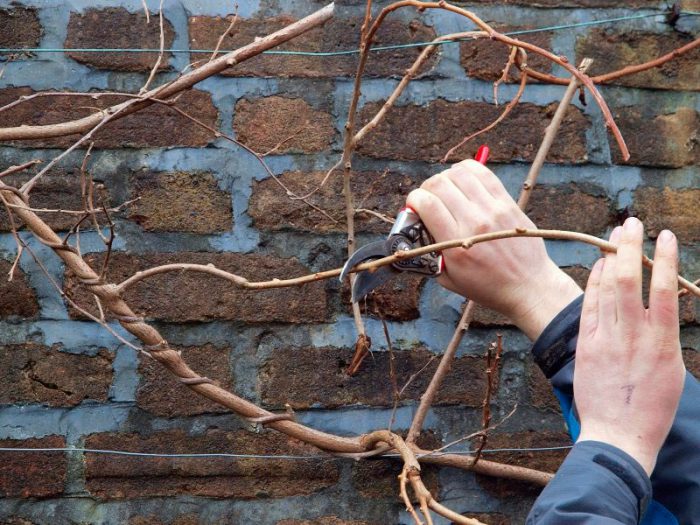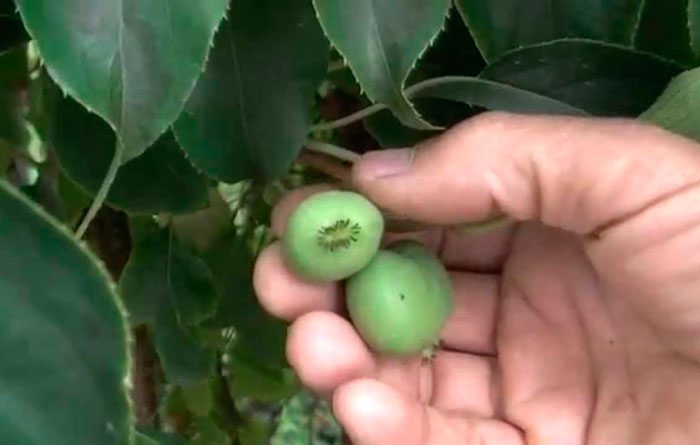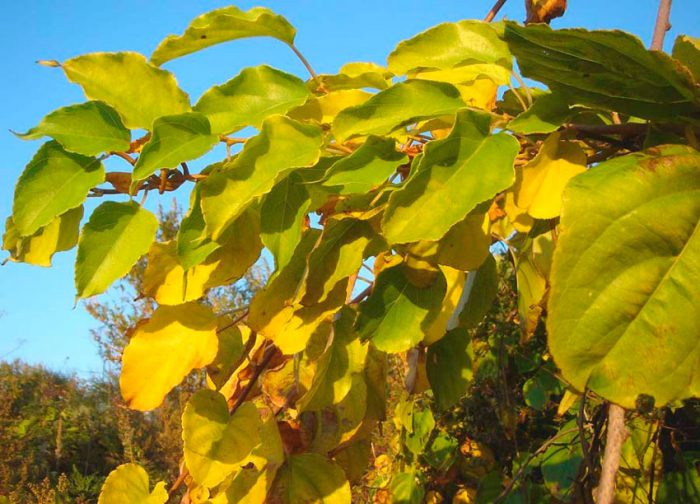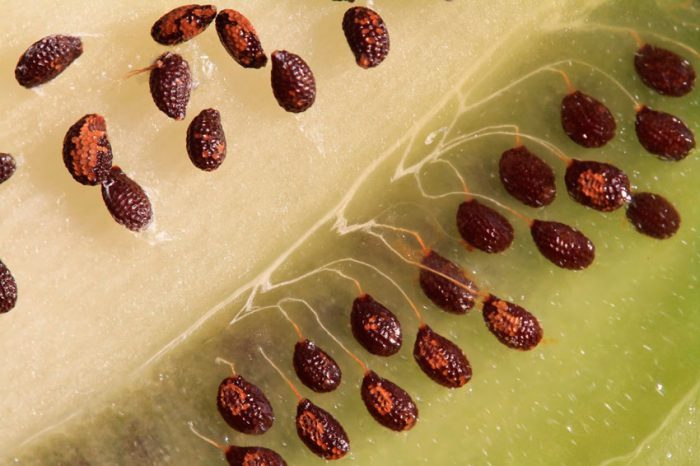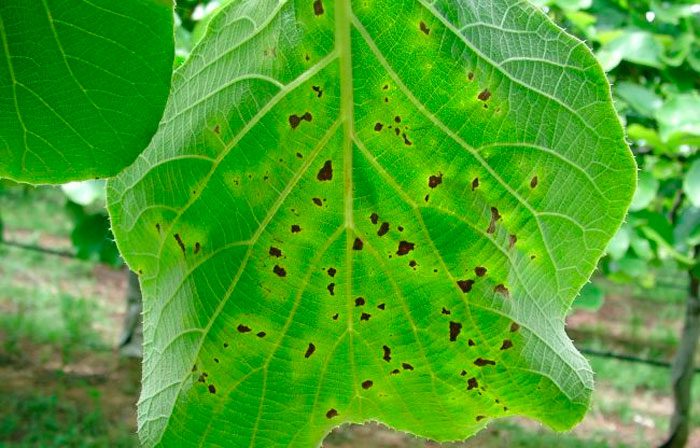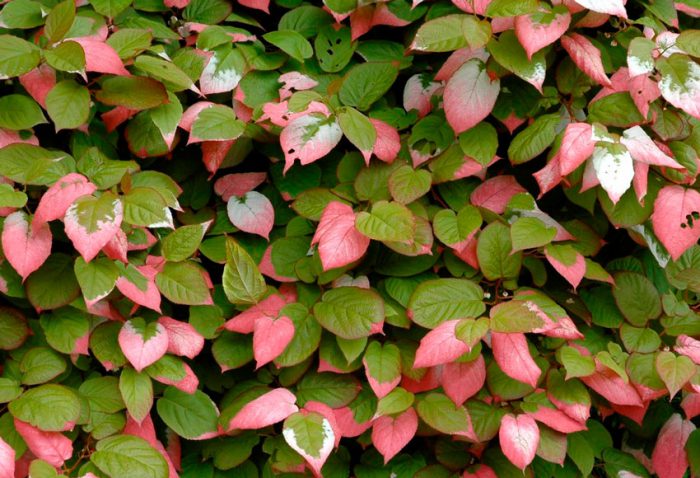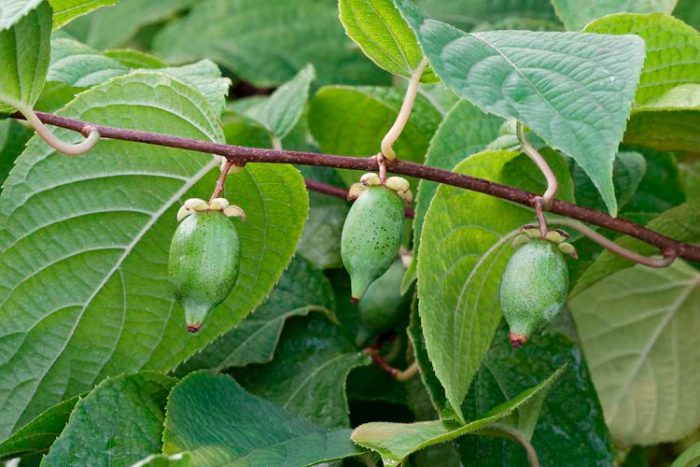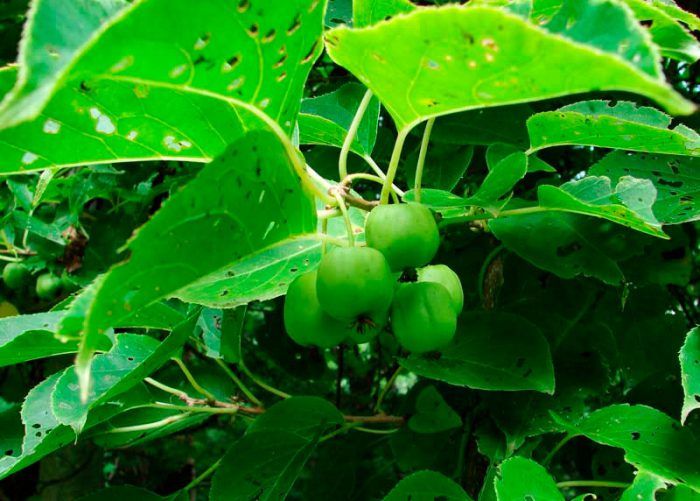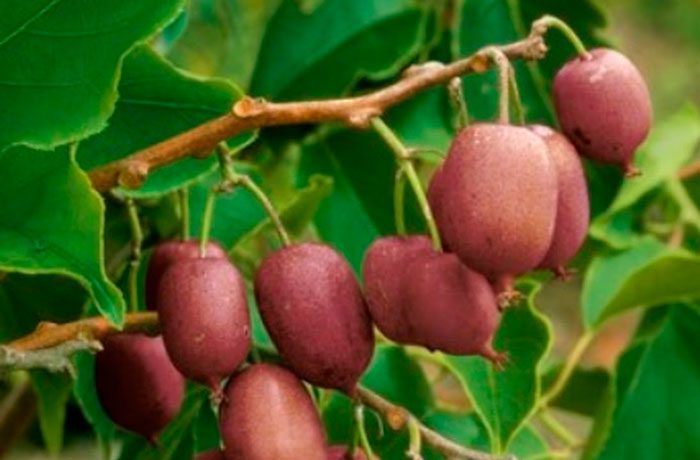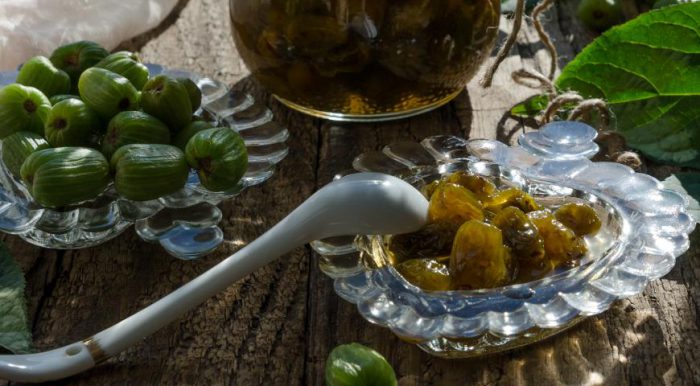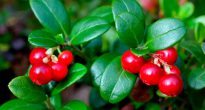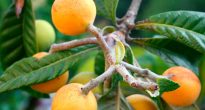Actinidia (Actinidia) is a member of the genus woody lianas and part of the Actinidia family. In the wild, such a plant can be found in Southeast Asia, the Himalayas and the Far East. This genus unites about 70 species. Almost every person knows a fruit of such a type as a delicious anemone - this is kiwi. Such a vine comes from China, while its fruits were in Europe only in 1958. The name of this vine was derived from the Greek word that translates as "archer". Today, in temperate latitudes, species are cultivated that are related to the gourmet sea anemone, but their fruits are usually not very large and less shaggy when compared to kiwi. Among the cultivated species cultivated by gardeners, the leader is the actinidia kolomikta: this garden actinidia is highly resistant to frost. Acute actinidia (arguta) is the largest species of this genus, the height of such a vine can reach up to 30 meters.
Content
Features of actinidia
Actinidia is a perennial deciduous vine. The leaf plates are solid, in some cases they are leathery, but sometimes they are thin. Actinidia is highly decorative due to its variegated foliage, since such plants can be seen quite rarely in mid-latitudes. Shoots and stems of such a vine need support. In the scars of the leaf plates are the kidneys. The flowers are mostly solitary, but they can also form small groups of three, they are collected in the leaf axils. Quite often, white corollas are found in actinidia, but in some species their color is yellow with a golden tint or orange. Flowers in most species are devoid of aroma, but in some species they have a pleasant odor, for example, polygamous actinidia.
What are the differences between female actinidia and male
This dioecious plant has both male and female specimens. What kind of sex the actinidia you have grown can be found out when it blooms for the first time, this is determined by the structure of its flowers. But what are the differences between the male and female copies? The flower of the male plant has a large number of stamens, but the pistil is absent. The flowers of the female plant have a pistil in the central part, which is surrounded by stamens that have sterile pollen that is not capable of pollination. On female specimens, pollen comes from males with the help of bees, bumblebees and the wind. It is on the shoots of the current year that buds appear, and they are located in the leaf axils. The plant blooms for about a week and a half, then ovaries appear in female specimens, which eventually form into pale orange or greenish-yellow fruits. Since such a vine is dioecious, in order to obtain fruits, it is necessary that at least two specimens be grown in the garden, so they will have the opportunity to pollinate. The fruits of such a vine are quite a valuable dietary and food product; they contain a large amount of ascorbic acid, sugars and other biologically active substances. Such fruits are eaten fresh, and also used for making drinks, jams, wines, and they are also dried. The dried fruits of this plant are similar to very large raisins. Over the past few decades, the popularity of actinidia among gardeners has grown significantly, and therefore it is quite possible that after a while it will be as common a crop as strawberries, currants or raspberries.
Planting actinidia in open ground
What time to plant
It is necessary to plant actinidia in open soil at the beginning of the spring period or in the fall. To do this, you need to purchase a bush in the nursery, the age of which will be from 2 to 4 years. The place for planting must be chosen with great care, because with proper care, such a plant can grow in one place and bear fruit for more than 30 years. But this is only if the gardener strictly adheres to the rules of agricultural technology of this culture. Such a liana is shade-loving, but it needs sunlight to ripen the fruits. In this regard, the best place to plant it will be a sunny area, which will be in shade in the afternoon. Actinidia has an extremely negative attitude to the neighborhood with an apple tree, however, it can be planted next to a currant. This vine cannot be grown on clay soil. The substrate should be moist, loose, well-drained and not alkaline. If the groundwater is shallow, then for planting this vine you will need to make a hill from the soil. It is very good if the site is located on a slope or on a hill, since there the liquid does not stagnate in the root system, but flows down itself. It should also be noted that this plant needs an obligatory support, for example, it can be a fence or a wall of a building, but it is best to use a special trellis for actinidia. With this design, you can form a plant, for example, in the shape of an arch, the fact is that the fruits are located in the upper part of the crown, and therefore, when grown near a building, they will have to be collected from its roof.
Spring planting
Planting the plant should be done in the first spring weeks before sap flow begins. If you are planting actinidia agruta, then it should be borne in mind that this is a rather large liana, and therefore a distance of 150-200 centimeters should be kept between the plants. When planting actinidia kolomikta, a distance of about 100 centimeters is left between the specimens. In the event that this vine is used as a decor for the wall of a building, then it must be planted at a distance of 50 centimeters, while organic matter must be introduced into the prepared trench. Before proceeding with the direct planting, the seedling will need to be prepared.To do this, it is necessary to remove all dried and injured branches and roots, the root system should be immersed in a clay mash before planting. The landing pit is prepared half a month before the day of disembarkation. Its size should be 0.5x0.5x0.5 m, at the bottom a layer of pebbles, broken brick or small stones for drainage should be made. Please note that the use of construction crushed stone is prohibited, since it contains lime so unloved by this plant. After that, the pit must be filled with nutritious soil mixed with peat (humus or compost), and 250 grams of superphosphate, 120 grams of ammonium nitrate and 35 grams of potassium sulfate or wood ash must be added to it. You can not apply fertilizers to the soil, which include chlorine, for example, potassium chloride, since because of it actinidia can die. After 14 days, the soil in the hole will settle, and you will need to make a slide in it from simple garden soil. A seedling is placed on this hill so that its root collar is flush with the soil surface. Then the pit must be gradually filled with earth, which should be well compacted. The planted actinidia needs to be watered abundantly; for this, 20-30 liters of water are taken per 1 bush. The surface of the tree trunk must be covered with a layer of mulch (compost), the thickness of which should be 40-50 mm. Until the seedling takes root, it must be protected from direct sunlight, for this it is recommended to cover it with a cloth or paper. Cats simply love the smell of actinidia, in this regard, the vine must be protected from them. To do this, it is necessary to dig a metal mesh around the plant to a depth of five centimeters, the height of which must be at least 50 centimeters.
Autumn planting
In autumn, the liana is planted in open ground 15–20 days before the first frost, and only seedlings no older than 2-3 years should be used, otherwise the plant will not be able to survive the first winter, as it will take a long time to take root. It is necessary to plant actinidia in open ground in the autumn in the same way as in the spring.
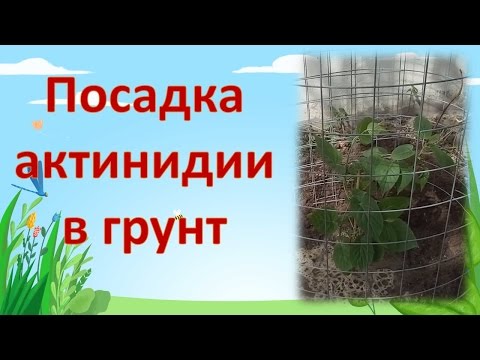

Watch this video on YouTube
Which support is suitable
Such a vine has no air roots, so it is not capable of damaging the structure. In this regard, it can be safely planted near the walls of buildings, using them as a support. It is very often used to decorate gazebos. If there is no support, then the plants get tangled, which greatly complicates the care of them, while the number of fruits may decrease. Experienced gardeners choose classic forms of pergolas and arches as supports, which can be metal, wood and concrete. Also, between two concrete, not very high posts, you can stretch a galvanized wire, and at the same time 3 or 4 rows are made according to the principle of a grape trellis, this will allow actinidia to grow horizontally. As the shoots grow, they should be tied to a trellis. In regions with cold winters, removable tapestries are often used. They are made from a metal corner, it is inserted into pipes that should be dug into the ground. Before frosts begin, such a trellis should be pulled out of the pipes and carefully placed on the surface of the site, while it is not necessary to remove the vine from it, but it is necessary to cover it well. In springtime, these tapestries return to their usual place.
Actinidia care
During the growing season, actinidia needs to be watered in a timely manner, removed weeds, cut, fed, and it is also necessary to monitor the health of the vine, and, if necessary, treat it for diseases or destroy pests. Moreover, any type of actinidia must be looked after in the same way. It is recommended to moisturize such a plant in the morning and in the evening by spraying, this procedure is especially important in hot weather.With prolonged drought, the vine begins to shed its foliage, in order to prevent this, the soil should be moistened 1 time per week, while 60 to 80 liters of water are poured under 1 bush. If all the leaves of the liana nevertheless fall off, then the young leaf plates that have appeared in their place will not be able to get stronger until frost and will freeze. The surface of the soil near the bushes should be loosened quite often, but at the same time to a not very great depth. Weeding is also carried out while loosening the soil.
Fertilizer
If you feed the plant with mineral fertilizers, this will lead to an increase in frost resistance and an increase in the yield of the vine, and the growth of young shoots will also be activated. At the very beginning of the spring period, for every 1 square meter of soil, 20 grams of potash and phosphorus and 35 grams of nitrogen fertilizers must be applied. The second time the plant should be fed during the formation of the ovaries, for this, for each 1 square meter, 10–12 grams of potassium and phosphorus and 15–20 grams of nitrogen fertilizers should be added. When all the fruits are harvested (around mid-September), the vine needs to be fed again. To do this, for every 1 square meter, 20 grams of phosphorus and potassium fertilizer should be applied. Fertilizers are purchased in granules, which should be distributed over the site and buried 10-12 centimeters into the soil. After this is done, water the actinidia liberally.
Pruning actinidia
If you take care of the plant correctly, this leads to stimulation of the growth of the stems, and also the buds begin to awaken. Very often the result is a strong thickening of the crown. If the crown is excessively dense, this will negatively affect the frost resistance and productivity of the plant. Therefore, it is very important to carry out formative pruning in a timely manner, but only plants that have reached 3-4 years old can be subjected to it. You need to cut the plant during the summer period, while those branches that remain should be distributed over the trellis, directing them in the direction you need. In order for the wood to mature better by winter, it is necessary to pinch the tips of the shoots, which will slow down their growth. If the trellis is horizontal, then a double-arm cordon is made of the stems, for this you need to be at the same level and in the same plane, direct 2 stems in opposite directions and fix them in this position, the remaining shoots of this level must be removed. Next year, on these horizontal branches, stems of the second order will grow, ovaries will form on them. These shoots should be tied to a vertical guide, as they grow, they themselves will begin to curl around it. To replace old skeletal branches, you will need anti-aging pruning, which is needed for plants that are 8-10 years old. After such pruning, only a stump should remain from actinidia, the height of which should be from 0.3 to 0.4 m.It is impossible to cut the vine at the beginning of the spring and at the beginning of the autumn period, the fact is that at this time actinidia has a very strong sap flow, and when damaged, she can drain out of juice, which will lead to her death.


Watch this video on YouTube
After harvesting the fruit
When the liana turns 3 or 4 years old, it has the first fruits, but it begins to give good harvests from the age of seven to old age. So, actinidia can bear fruit for 40 years or even longer. If you take care of the plant correctly, then about 60 kilograms of fruit can be harvested from one specimen per season. Fruits do not ripen at the same time, but they do not fall off the bushes for a long time. Harvesting begins in mid-August, and in some cases, harvesting ends only in mid-September. When the vine is freed from the fruit, it needs feeding, which will allow the plant to survive the winter normally.
Care in autumn and winter
Young seedlings growing in the garden for no more than 2 or 3 years must be removed from the support and well covered using spruce branches, peat or fallen leaves.The thickness of the covering layer should not be less than 20 centimeters, while experienced gardeners advise placing poison for rodents under it. The stalks of the mouse are not touched, but they make their nests in them. In April, cover should be removed from young bushes. Adult actinidia are subjected to sanitary pruning from mid to late September, while their stems are cut to 1/2 or 1/3 of their length, and all branches that contribute to the thickening of the crown must be cut out. You do not need to cover adult vines for the winter.


Watch this video on YouTube
Reproduction of actinidia
There is nothing difficult in the reproduction of actinidia, especially since the sex and varietal characteristics of the parent plant are inherited, but only if you propagate it vegetatively. When growing from seeds, you will not be able to determine which sex the seedling is, and in this case, the seedlings inherit the varietal characteristics of the mother plant quite rarely. However, it should be borne in mind that plants grown from seeds are distinguished by higher endurance, but they usually begin to bear fruit only at the age of seven. At the same time, those actinidia that were grown using the vegetative method give the first fruits at three or four years of age.
Reproduction of actinidia by arc layers
It is very simple to propagate such a vine with arc layers. In the spring, after the end of sap flow and the blooming of young foliage, it is necessary to find a well-developed and sufficiently long growth shoot, its top should be bent to the surface of the earth and fixed in this position. In the place where the shoot is pinned to the ground, it should be sprinkled with soil, while the layer thickness should be from 10 to 15 centimeters, then the resulting mound must be well watered and covered with a layer of mulch (sawdust or humus). It should be borne in mind that the top of the stem must remain free. Provide the shoot with timely weeding and watering, while the young shoot that has grown from it should be systematically moistened from the sprayer. By autumn, the cuttings should take root and can be planted in a permanent place. You can also transplant the layer next spring.
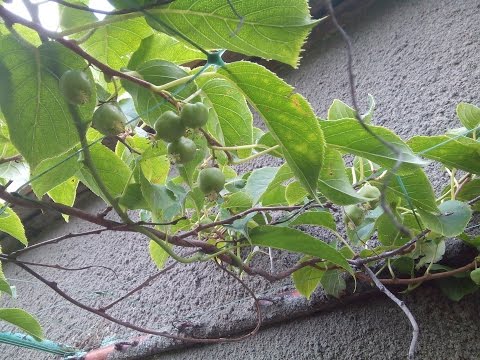

Watch this video on YouTube
Propagation of actinidia by cuttings
Actinidia can be propagated by green cuttings. With this method of reproduction, you can quickly and easily get a lot of seedlings. Cuttings are harvested in June, at this time the fruits grow very quickly, and the stems begin to lignify and change their green color to brown. It is necessary to choose several strong annual branches, which reach 50-100 centimeters in length, they need to be cut off from morning till lunchtime. The ends of the cut stems must be placed in a container with water, this will prevent the branches from withering. Then the shoots should be cut into several cuttings, the length of each of them should be from 10 to 15 centimeters. At the same time, remember that on each segment there should be 2 internodes and 3 kidneys. The upper cut should be straight and located 40–50 mm above the upper kidney. The bottom cut should be made at a 45 degree angle and it is made directly below the lower kidney. The lower leaf plates and their petioles must be carefully removed, while those plates that are located on top are shortened by ½ part. Prepared cuttings must be planted in a greenhouse or in a greenhouse, while the garden bed is made in advance and watered well. The soil should be slightly acidic or neutral, river sand and humus (2: 1: 2), as well as a complex mineral fertilizer, which does not include chlorine (per 1 square meter, 100 grams of substance), must be added to it. The cuttings are planted at an angle of about 60 degrees, the row spacing should be 10 centimeters, while between the plants it is necessary to maintain a distance of 5 centimeters. It is necessary to deepen the cutting so that its middle bud is flush with the surface of the substrate. Near the planted sections, the soil surface must be tamped.Then they are watered, and when the water is completely absorbed into the ground, its surface is covered with gauze rolled in 2 layers. Before the cuttings give roots, they need to be very well moistened with water from a spray bottle 2–5 times a day directly through cheesecloth. If the weather is rainy, then the gauze can be removed from the cuttings, and they do this in the morning and evening. Half a month after landing, the shelter is removed for good. For wintering, cuttings should be covered with dried leaves. In early spring, before the buds open, the rooted cuttings must be dug up and planted in a permanent place.
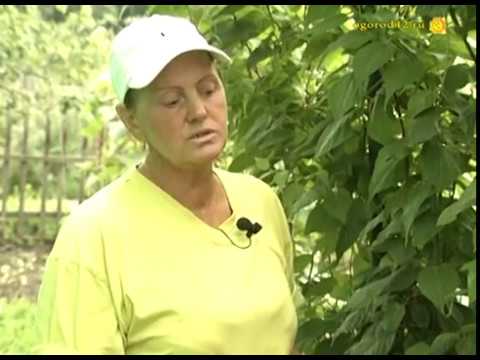

Watch this video on YouTube
Propagation of actinidia by lignified cuttings
Lignified cuttings are harvested in late autumn. They are tied in bunches, which are placed vertically in a box filled with sand. There they will be stored until spring. For storing cuttings, a temperature of 1–5 degrees is required. Harvesting of such cuttings can be done in the last winter weeks, and you must be in time before the start of sap flow. The cuttings are planted in a greenhouse or a greenhouse, once every two days they need to be watered. Further, they need to be looked after in the same way as for green cuttings.
Combined cuttings are also suitable for rooting. In the first summer weeks, it will be necessary to cut off the growing stem of the current year with the heel (part of the one-year branch adjacent to it). The planting of such cuttings must be done in a greenhouse or in a garden bed. They must be protected from direct sunlight and provided with daily watering. In this kind of cuttings, rooting occurs quite quickly, in this regard, as early as next year they can be planted in a permanent place.
Propagation of actinidia by seeds
The seeds must be removed from ripe fruit that has not been damaged. They should be kneaded, the resulting mass is folded into a mesh bag. It is thoroughly washed under running water, after which the seeds remaining in the bag are spread on a paper sheet. They are placed in a shaded area to dry. Seed preparation for planting should be started in early December. To do this, they are folded into a shallow container, into which water is poured so that it rises 20 mm above the seeds. Soaking the seeds will last for 4 days, while the water must be systematically replaced with fresh water. After that, the seeds must be poured into a nylon stocking, which is placed in a box filled with damp sand. The container with seeds must be removed to a place where the temperature will be kept within 18-20 degrees. Once every 7 days, the stocking must be removed from the sand. Allow the seeds to air, while only a few minutes will be enough, then they should be rinsed under running water right in the stocking. After that, they must again be placed in a container with damp sand. Make sure that the seeds do not dry out. In January, this box, along with the seeds and sand in it, should be wrapped in a cloth, and then it is buried in a very deep snowdrift. The seeds will stay there for 8 weeks. In the event that there are no deep snowdrifts on the street, the seeds along with the box will need to be placed on the vegetable shelf of the refrigerator. There they will stay in the same way for 8 weeks, then they take out the box and put it in a place where the air temperature fluctuates within 10-12 degrees. Remember that seeds should not be placed in heat, since after a cold they can fall into a dormant period. Seeds after stratification should be continued to be washed once a week and ventilated. After a few seeds have hatched, you can start sowing them. To do this, use containers filled with turf soil mixed with river sand, while they need to be buried into the substrate by only 5 mm. The emerging seedlings need regular spraying from a sprayer, and they also need to be protected from direct sunlight. After the seedlings have 3 or 4 true leaf plates, they are planted in a greenhouse, as a rule, this time falls in mid-June.The first flowers in such plants will appear at the age of three to five years, then it will be possible to transplant them to a permanent place after determining the sex.
Pests and diseases of actinidia
Diseases
Actinidia has a very high resistance to diseases and pests. If the plant is properly looked after, and when growing it, do not forget about the rules of agricultural technology, then such problems with it may not arise at all. In some cases, such a vine can become infected with a fungal disease, due to which spots appear on its foliage, for example, phyllosticosis, powdery mildew, etc. Actinidia is also susceptible to infection with diseases such as gray and green mold, and fruit rot, while actinidia argut suffers from them more often. Cut off all the infected parts of the vine (leaf plates, stems, fruits), for preventive purposes, it is recommended to spray the plant with a solution of Bordeaux liquid (1%) when the buds appear, the second treatment is performed half a month after the first. In order to get rid of powdery mildew, you need to spray the plant with a solution of soda ash (0.5%), while the second time it is treated 1.5 weeks after the first spraying.
Pests
At the very beginning of the growing season, the swollen buds of actinidia can be damaged by leaf beetles. When the larvae of these insects appear, they will begin to devour the leaf plates, from which only one vein will remain. Less often, the caterpillars of the peppered moth settle on the liana, they gnaw large holes in the foliage. Bark beetles and lacewings can also settle on such a plant. Therefore, it is very important in the spring to carry out preventive spraying of actinidia and the surface of the area around it with Bordeaux liquid, this will help to destroy overwintered pests and pathogens. In the fall, you should also make the same treatment with the same agent in order to exterminate pathogenic microorganisms and pests that have settled for the winter.
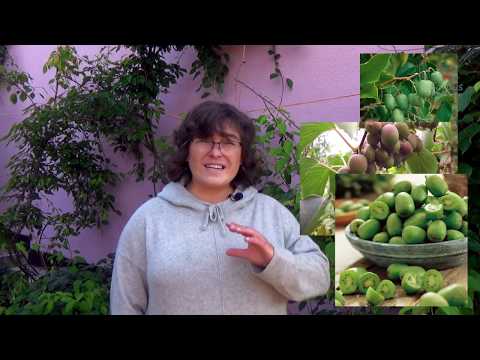

Watch this video on YouTube
Actinidia varieties with photos and descriptions
In the wild, there are a large number of species of actinidia, however, only 3 of them are cultivated by gardeners: actinidia colomicta, arguta and purple. And they also grow interspecific polygamous actinidia, Giralda and hybrid. A large number of various varieties of these subspecies and species are also cultivated. Their detailed description will be presented below.
Actinidia arguta (Actinidia arguta)
Of all the cultivated species, this one is considered the most powerful. In the wild, it can be found in the Far East, while the height of such a vine can vary from 25 to 30 meters. The trunk reaches 15-18 centimeters in diameter. Pointed ovoid leaf plates reach 15 centimeters in length and have a finely toothed edge. Such a dioecious plant is decorated with fragrant white flowers, reaching a diameter of 20 mm, they can be collected in a brush or single. The dark green spherical fruits can be eaten and have a slight laxative effect. In diameter, the fruits reach 15-30 mm, while they weigh about 5-6 grams. Fruit ripening occurs in the last days of September. Popular varieties:
- Self-fertile... This frost-resistant variety ripens relatively late, because its fruiting period starts from mid to late September. The deep green, elongated-cylindrical, fragrant fruits weigh 18 grams. From one bush, they collect from 10 to 12 kilograms of fruits.
- Primorskaya... This self-fertile variety requires male plants. Resistance to frost is average, and to pests and diseases - high. Soft smooth green leaf plates are of medium size. Elliptical olive-colored fruits weigh 6.6–8.3 grams, the flesh is very delicate, covered with a thin skin, it has an apple smell and high taste.
- Large-fruited... This dioecious variety is resistant to drought and frost. Medium ripening fruits.They have an elliptical shape, a dark green color with a blush, weigh 10-18 grams, and reach 2 centimeters in length. The pulp is slightly aromatic, its taste is honey.
In addition to these varieties, gardeners often grow such as: actinidia Relay, Mikhneevskaya, Ilona, Zolotaya Kosa, Vera, September, Lunnaya, etc.
Actinidia kolomikta (Actinidia kolomikta)
This plant is very resistant to frost. Its height can be 5–10 m. The trunk reaches two centimeters in diameter. Ovate leaf plates in length can reach 7-16 centimeters, they have a sharp-serrate edge, there is a light red pubescence on the veins. The petioles are pale red. In male actinidia, the leaf plates have a variegated color, namely, in July, the upper part of the leaf plate is painted white, then light pink, and then deep crimson. In autumn, the foliage also looks very impressive, as it turns purple-red and pink-yellow. Such a vine is dioecious. Fragrant white flowers on male specimens are collected in racemose inflorescences of 3-5 pieces, and on female specimens - single. The length of green fruits is from 20 to 25 mm, they can be eaten, in the sun they may appear bronze or light red. The fruits begin to ripen in August. Popular varieties:
- Pineapple... This fast growing dioecious plant is one of the most productive varieties. The oval fruits are about 30 mm long and have a green color and a red barrel. The pulp is delicious with a pineapple flavor.
- Dr. Shimanovsky... Such a variegated medium-term fruiting plant is winter-hardy. Green fruits reach 25 mm in length, and weigh about 3 g. The pulp is tender, sweet-sour taste with a pineapple-apple smell.
- Gourmet... This medium-ripening variety was born relatively recently. The length of large fruits can reach 3.2 cm, while they weigh 4–5.5 grams. The taste is sweet-sour pineapple.
Among gardeners, such varieties as actinidia Moma, Narodnaya, Wafer, Priusadbnaya, Prazdnichnaya, Slastena, etc. are also popular.
Actinidia polygama (Actinidia polygama)
The diameter of the trunk of such a plant is about 20 mm, it reaches 4–5 m in height. It is outwardly similar to the actinidia kolomikta. Elliptical, oblong sheet plates are pointed towards the apex and have a serrated edge. On the surface of the green plates there are specks of silvery color; in autumn, the foliage color changes to yellow. White, fragrant flowers are usually solitary and dioecious, but there are also bisexual flowers. The fruits weigh about 3 grams and can be eaten. Popular varieties:
- Apricot... Late ripening, the variety has moderate resistance to frost, and high - to diseases and pests. Such a plant is self-fertile (male specimens are required). The fruits are flattened on both sides, they reach 35 mm in length and weigh 6 grams. The sweet-sour pulp has a balm scent.
- Beauty... This variety is highly resistant to diseases, pests and frost. The green-yellow fruits have a strong odor and weigh up to 3.5 grams. The pulp is slightly sour.
- Patterned... This variety is late. Elongated cylindrical orange fruits on the surface have longitudinal stripes that are hardly visible. The smell and taste is peppery-fig.
Actinidia giraldii (Actinidia giraldii)
Some scientists believe that this plant is a variety of arguta actinidia, but its fruits are much larger and sweeter. In the wild, this species is extremely rare, so it was included in the Red Book. Therefore, if you decide to cultivate this vine on your site, you will help to preserve this rare species. Popular varieties:
- Juliana... Late variety. Fruits are green, compressed from the sides, weighing 10-15 grams. The smell of the pulp is pineapple-apple, it is sweet.
- Alevtina... The green barrel-shaped fruit is compressed from the sides, weighs 12–20 grams. The sweet pulp has a pineapple-apple-strawberry aroma.
- Native... This variety is late.The shortened barrel-shaped fruits are compressed from the sides, weighing 7-10 grams. The pulp has a pungent pineapple smell.
Actinidia purpurea (Actinidia purpurea)
The birthplace of this powerful tree-like dioecious plant is China. This vine is shade-loving, and it is distinguished by lush flowering and abundant fruiting. The color of the large sweet fruits is purple and ripens in the last days of September. This species has only one drawback - low resistance to frost. At the moment, there is only the Purple Sadovaya variety: dark burgundy oval-shaped fruits reach 25 mm in length, and weigh 5.5 grams, the smell of sweet pulp is delicate marmalade.
Actinidia hybrid
This subspecies was born thanks to the breeder I. M. Shaitan from Kiev. It was he who crossed actinidia purple and argut. The result of this was the appearance of completely new varieties with high resistance to frost and very large fruits, which is characteristic of actinidia arguta, as well as with taste, smell and bouquet type of flowering and fruiting of actinidia purpurea. Specialist Kolbasina after a while continued the works of Shaitan. Popular varieties:
- Kievskaya Large-fruited... This is a late variety. Large, green, oval-shaped fruits weigh about 10 grams. Their tender pulp is very sweet.
- Candy... This variety is late. The oval-shaped fruit is green in color and weighs about 8 grams. The sweet pulp has a fruity-caramel flavor.
- Souvenir... The color of the fruits is red-green, they weigh about 8 grams. The sweet pulp has a candy-fig-fruit aroma.
Every year the following varieties of this subspecies are becoming more and more popular: Actinidia Hybrid Sausage and Actinidia Hybrid-10.
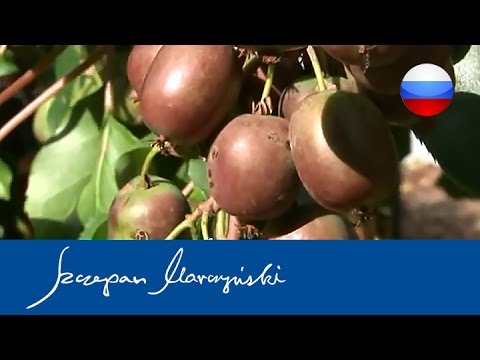

Watch this video on YouTube
Actinidia properties
The fully ripe actinidia fruit contains fiber, starch, carotene, sugars, pectin substances, vitamins, mineral salts, phenol carboxylic and organic acids, nitrogen-containing compounds, saponins, alkaloids and other substances that the human body needs. They contain vitamin C, while it is much more than lemons, oranges and black currants. Also, these fruits include vitamins A and P, and their seeds contain a large amount of fatty oils.
Experts advise eating such fruits for diseases of the gastrointestinal tract, for anemia, for pulmonary diseases (up to tuberculosis), even for rheumatism, vitamin deficiency, gonorrhea, scurvy, lumbago, colitis and caries.
Other parts of the liana are not devoid of healing properties. For example, the bark contains cardiac glycosides and tannins, due to which it has a sedative, tonic, expectorant and hemostatic effect.
Actinidia is often used for belching, heartburn and other problems with the digestive system, it also has an unexpressed laxative effect and improves the digestion of meat.
On the basis of this plant, the drug "Polygamol" was developed, it has a general strengthening property, it is also able to support cardiac activity and increase diuresis. For angina pectoris, actinidia tincture is used. Infusion and decoction, prepared from the roots, are used externally for radiculitis, painful sensations in the joints and for gout. The peel and juice of the berries improve appetite and have a wound healing effect.
Also, this plant is used during the treatment of colds, bleeding, as well as when getting rid of parasites. An ointment is made from the berries, which is used after bone fractures, and also for massages.
Contraindications
Any new product or drug should be used with caution. Actinidia has no special contraindications. However, eating its berries should be abandoned by those who suffer from varicose veins, thrombophlebitis, and also people with high blood clotting. If you eat a lot of such fruits, then this can cause the development of an intestinal disorder.
Healthy recipes
There are many very healthy recipes for actinidia, for example:
- Infusion of fruits... Dried fruits must be placed in a container with water. They are boiled over low heat for 60 minutes. The cooled infusion must be filtered. The infusion is consumed after a meal in small portions, it helps to prevent cancer.
- Berry ointmentwith a regenerating effect. Fresh berries must be ground very well. They are combined with crushed mustard seeds and with a fat base (for example, you can take lard). This ointment is used after fractures and during massage.
- Bark decoction... 20 grams of bark must be crushed very well. Then it is combined with 1 tbsp. freshly boiled water and kept in a water bath for 30 minutes. The cooled infusion must be filtered. If metabolic processes in the body are disturbed, they drink such an infusion in 2 or 3 large spoons 3 times a day.
- Infusion of flowers and foliage... Take 20 grams of crushed leaf plates and flowers. The mixture must be combined with 1 tbsp. freshly boiled water, then it is kept in a water bath for a quarter of an hour. The cooled infusion must be filtered. It is necessary to drink the infusion 3 times a day for 1/3 tbsp. with angina pectoris and rheumatism.
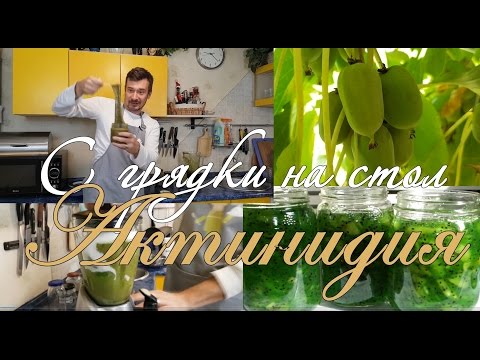

Watch this video on YouTube

